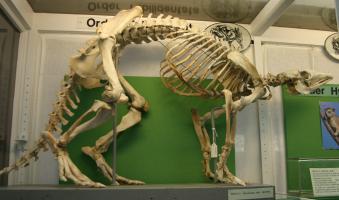
ORDER TUBULIDENTATA: THE AARDVARKOnly living member - the aardvark - Orycteropus afer . The postcranial skeleton is very unspecialised - strong resemblance to some very early ungulates. The limbs have undergone no elongation, and the hoove-like claws are modified a little for burrowing.
Behaviour & Ecology: The aardvark is nocturnal, resting in a burrow during the day and foraging in termite mounds at night. Little else is known about the aardvark. The specialisation of the aardvark make it vulnerable to changes in its termite food supply as a result of habitiat disturbance.The aardvark is also at risk from hunting - some indigeneous cultures use its hair and claws for medicinal and 'magic' purposes.
The skull of the aardvark is highly specialised, adapted for its diet of ants & termites (Compare with the anteater/pangolin). Features of note include:
These teeth are constructed of small tubules of dentine compressed together, giving the Tubulidentata its name. They have cement instead of enamel. |








